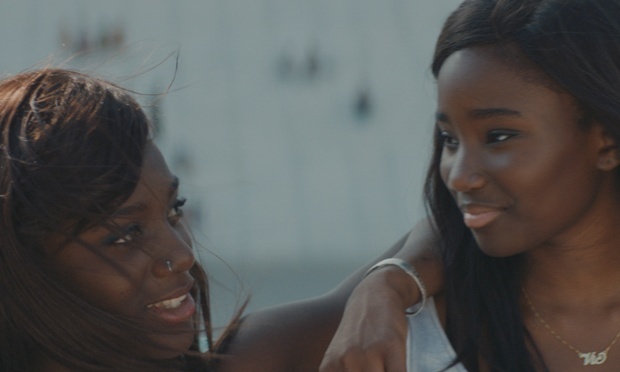
by Miranda Schiller @mirandadadada
Girlhood is the story of Marième’s journey from obedient child to defiant girl gang member to young adult fending for herself. It is a story of black female teenagers in the suburbs of Paris. It is a story of female friendship. It is a story of strength, of finding your way out.
Marième grows up with many restrictions. Her mother is mostly at work, leaving her to look after her two younger sisters. Her older brother is abusive, violent and intimidating. There does not seem to be a father. The boy she likes does not want to date her because of established power structures involving his friendship with her brother. Her teachers are not overly interested in helping her succeed at school, but when she learns that she is not accepted into the next grade and her only option is a vocational course, Marième has had enough. She is angry, an emotion which will not leave her, and which will give her the power she needs.
She joins a small gang of three other girls of the neighbourhood and, for the first time, does whatever she wants. They take money from younger girls, they steal dresses, they get involved in fights, and they let no opportunity pass to verbally confront other groups of girls. But while not glossing over these realities of Cité girl gang life, director Céline Sciamma puts more emphasis on the beautiful moments of friendship the girls experience.
They use their stolen money to buy some rum and coke and rent a hotel room for a night, where they glam up with dresses that have the theft tags on. They are not dressing up to go out, they are just testing out their femininity and having fun together. One of the strongest scenes of the film has the four of them dancing to Rihanna’s Diamonds in the Sky in the hotel room. Starting with a close-up on gang leader Lady’s face, lip-synching perfectly, it is shot like a music video, showing a vision of the girls for themselves rather than the reality. Until Marième, Lady (Asa Sylla) changes her name to Vic for Victory, joins in and pre-empts two story developments: Her overtaking of Lady’s leadership role, and a turn towards a more reality-oriented outlook on life, leaving the gang behind. Just one instance of the sophisticated editing that is driving the story just as much as the wonderful actresses.
Karidja Touré as Marième / Vic, like most of the cast, has had no acting experience and has been cast on the streets of Paris suburbs. She puts an electrifying energy into her role. Her face can switch from disappointed anger to childlike happiness in an instant, transporting the ambivalence and insecurity of her life especially, but also of growing up generally, experienced by teenagers everywhere.
Although relatable for anyone who has been through growing up, Girlhood is still distinctly about underprivileged female black teenagers. It is not lack of intelligence that denies them social mobility through education, but once that option is gone, the only apparent prospects for these girls are either marriage, service jobs, or a life of crime – Marième will not settle for any of these, but instead of a fairytale ending, what Girlhood offers is a strong-willed young woman who knows only the one thing: That she will not be defeated.
Sciamma shows the impasses and ways of resistance with visual means, drawing on all the things film can do. When Marième is told she cannot come back to high school after the summer, the camera locks on her, imploring the teacher to give her another chance – the teacher herself is never shown, only heard from the off. A sterner depiction of a teacher could not have been more effective.
The girls’ hair features heavily the story. Rarely talked about, but always visually present. When Marième joins the gang and becomes Vic, she trades in her good-girl cornrows for a straight weave. She lovingly undoes her little sister’s stiff chignon in a touching scene of sisterly encouragement. When Lady is publicly humiliated and even the girls don’t seem to be able to restore her reputation, her father adds to the humiliation by cutting her glamorous weave off, leaving her hair short and damaged. Vic finally resorts to masculine short braids when she is trying to hide her femininity to protect herself in the underworld she has taken refuge in.
There are millions more examples of cinematic craftsmanship in Girlhood, probably more than can be perceived at first viewing, which is all the more reason to watch it more than once and to revel in the strong impression it leaves long after it has ended.
Girlhood is on general release from Friday 8th May.